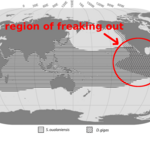Ecology & Zoology

I'm here today to talk about a very strange paper: Penetration of the oral mucosa by parasite-like sperm bags of squid: a case report in a Korean woman.
This study, published in February in the Journal of Parasitology (?!), presents the tale of a woman eating squid who experienced "severe pain" and a "pricking, foreign-body sensation" in her mouth. A doctor found and removed "twelve small, white spindle-shaped, bug-like organisms" from her tongue, cheek, and gums.
These foreign bodies were subsequently identified as squid spermatophores, which I would like to point out are not "organisms…

A few years ago, Netherlands Institute of Ecology (NIOO-KNAW) researchers discovered that soil-dwelling and above-ground insects are able to communicate with each other using the ragwort plant as a kind of telephone.
Insects eating plant roots change the chemical composition of the leaves, causing the plant to release volatile signals into the air. This can convince aboveground insects to select another food plant in order to avoid competition and to escape from poisonous defense compounds in the plant.
Apparently the communication doesn't stop there.
Those same plant insects…

Sometimes natural is not good. Actually, a lot of the time natural is bad but we live in in era where anti-science types have a 'natural' fetish, believing anything natural is good.
But not always. Weeds are natural yet if you leave them alone your vegetables will die. And that goes for plenty of other invasive species. Even wild salmon.
There's long been precautionary principle hysteria that farm-raised salmon - created so we could all benefit from the health effects of eating fish without risking overfishing - would cause disease among the wild population. Who knew…

Dear squid blog, I am sorry that so many other projects have been keeping me from you lately! My love for squid remains undimmed. Just to prove it, I will share with the world a helpful chart that I drew several years ago and recently unearthed.
The Humboldt squid (Dosidicus gigas) and the purpleback flying squid (Sthenoteuthis oualaniensis) can look very similar. If you're fishing in a location where only one of them lives (like Indonesia for Sthenoteuthis or California for Dosidicus), no problem. But in certain areas of the Pacific Ocean--oh look I have a map--their ranges…

Honduras is now a permanent shark sanctuary so any shark fins found are illegal - the International Union for Conservation of Nature says that 30 percent of all shark populations around the world are threatened or near threatened with extinction.
Shark fins are worth $300 per pound in the global marketplace but they are illegal in Honduras and five other countries; Palau, the Marshall Islands, Tokelau, the Bahamas, and the Maldives. Together those comprise more than 1.8 million square miles of ocean. On June 24, 2011, President Porfirio Lobo Sosa announced a permanent…

Jonathan Wong, Vancouver Aquarium
HuffPo has some fantastic photos and a video up from the Vancouver Aquarium. The species is Doryteuthis (once was Loligo) opalescens, sometimes called the inshore opalescent squid or market squid.
The video has great footage of the arms moving, chromatophores expanding, hearts beating, etc. Check it out!(Let it be noted, though, that baby Humboldt squid (Dosidicus gigas) are even smaller and therefore cuter.)

Usually "No Change in X" doesn't make a very splashy headline, but when the lack of change occurs over 160,000,000 years and X is squid ink, people get excited.
And with good cause. This is the first time that ink from a fossil cephalopod has been analyzed chemically, and it turned out to be indistinguishable from modern cephalopod ink. One hundred and sixty million years. No change.
For context, 160 million years ago was smack in the middle of the Jurassic, when the land was covered with sauropods and the ocean was full of ichthyosaurs. What were cephalopods doing? Well, they were…

It is very difficult to achieve this goal. Typically, fisheries undergo stocks permanently at different temporal and spatial scales of exploitation that exceeds the biological capacity and ecological recovery of the species. Plus, the fishery always begins without further study of the population which will be exploited. When these studies exist, and these are more intensive, the population has already changed to another phase, i.e., the response is delayed
One factor that clearly shows these effects are average sizes of the populations subjected to exploitation. Body sizes of fish as…

A group of studies says that salmon raised in man-made hatcheries can harm wild salmon through competition for food and habitat. Salmon, which survived millions of years of evolution, are in danger from...salmon.
The studies provide new evidence that fast-growing hatchery fish compete with wild fish for food and habitat in the ocean as well as in the rivers where they return to spawn and even raises questions about whether the ocean can supply enough food to support future increases in hatchery fish while still sustaining wild salmon.
"This isn't just an isolated issue," says Pete…

My very first mentor in cephalopod research was Eric Hochberg at the Santa Barbara Museum of Natural History. I think I was seventeen when he welcomed me into the museum's secret catacombs (at least, that's how I thought of them) of preserved specimens. Awe washed over me as I stared at shelves upon shelves of jarred octopuses.
Eric introduced me to the California pygmy octopus, Octopus micropyrsus, which would proceed to fascinate me for the rest of my undergraduate career. I saw more of them in jars than I ever did alive, though I kept doggedly digging through kelp holdfasts trying to…